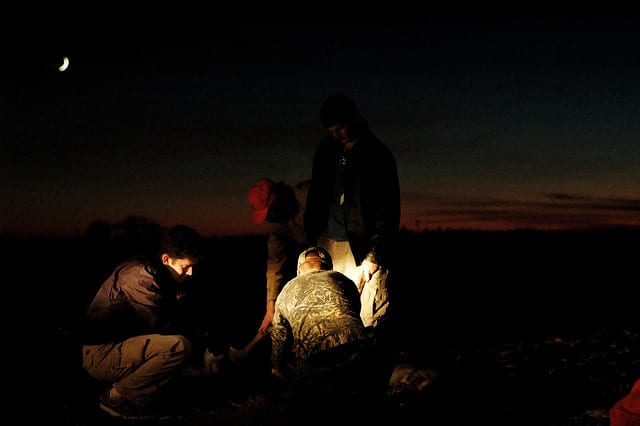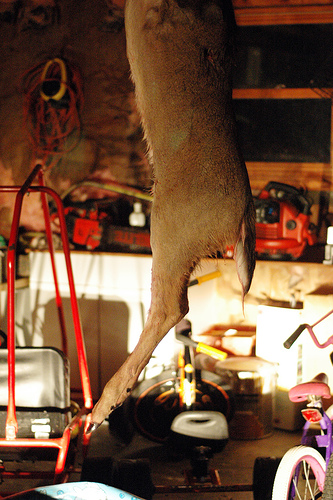How To Field Dress a Deer
OutdoorHub 11.09.11

Steve Glass is a passionate hunter who is also passionate about his food from wild game. In order to avoid spoiled or “gamey” tasting meat Glass has developed a cooler bag to transport animals, Trophy Bag Kooler. With his expertise, Glass helped Outdoor Hub outline detailed guidelines to properly handle your harvest. Read the full article here. In this article, we take an in-depth look into proper deer field dressing to achieve maximum flavor and ensure proper handling to eliminate the multiplication of bacteria and prevent other diseases from entering the carcass.
Always be prepared for the hunt. Remember to bring a good butcher kit or a sharp hunting knife, a bone saw, a small hatchet, a whetstone or steel sharpener, at least 12 feet of light rope or nylon cord, plastic bags, and a good supply of paper towels, rubber medical gloves and fresh water. You may also need proper clothing, binoculars, a compass, a map, an emergency survival blanket and matches.
Field Dressing
There are three major rules to follow as soon as the animal is down:
- Remove the intestines, heart, liver and lungs as soon as possible.
- Keep the carcass clean by getting it off the ground as quickly as possible and by using clean knives during dressing.
- Cool the carcass quickly and keep it cool during processing and transport.
When field dressing an animal, Glass always recommends using plastic surgical gloves. You never know what kind of bacteria or disease a particular animal may carry. Clean your hunting knife often with an antimicrobial spray or with clean water and wipe off with paper towels to prevent contamination of the meat.
- Place the animal on its back with the front-end elevated and spread the hind legs. Support the carcass in position by placing rocks or sticks on each side or tie a leg to a tree.
- Cut around the anus and make sure to separate the membrane from the wall, loosening this will allow it to come out with the guts. Next cut around the genitals and separate the male organs, be sure not to cut the bladder or pee pouch as this will taint the meat. Cut along the mid-line of the belly from the breastbone to the anus. Avoid cutting into the paunch and intestines by using a knife with a gut hook or a special blade designed for this purpose. Trophy Bag Kooler offers several products on the company’s website.
- Cut the diaphragm (the thin sheet of muscle and connective tissue between the chest and the abdomen) free from the rib cage by cutting through the white tissue near the rib cage.
- Reach forward to cut the windpipe, gullet and blood vessels at the base of the throat. Glass finds it easy to put two fingers in the windpipe and pull down. The heart, liver, lungs and guts will come out of the animal relatively easy. If you like variety meats, save the heart and liver in a plastic bag and put on ice.
Bleeding the Animal
Never sever or cut the throat, this is an old myth. This is especially true if the animal is a trophy buck and you plan to mount it. Severing the throat can cause problems for the taxidermist during mounting process. You cause more harm than good.
Most of the time the damage by the shot placement will bleed the animal sufficiently and any hang time will help drain any excess fluids. When the animal has been shot in the vital organs, internal bleeding into the chest cavity should be enough. Most other shots take additional bleeding. Severing the large blood vessel leading to the heart should get any additional blood to drain out.
If possible hang the carcass to clean and allow it to drain or put the carcass on logs or rocks if you can’t hang it. Be sure to keep it out of reach of the critters.
- Remove all foreign particles and loose hair.
- Wash out excess blood in the gut cavity and wipe out with a paper towel or clean cloth. Remember, water promotes the growth of bacteria, so when using water always wipe off the excess and then treat the inside of the gut cavity or eviscerus with the Game Fresh Spray and don’t forget to treat the wound channels. This will eliminate any bacterial growth and help start the preservation process. Also remember, several different kinds of bacteria already exist and you need to kill it so it won’t start multiplying.
- Use as little water as possible on the hide, because a wet hide is a breeding ground for bacteria and it will spread to the meat. Dry with paper towels or clean rags.
- You want to prop the cavity open with sharpened sticks or a product Glass uses called Steel Stick. It’s a rib spreader. This will allow the carcass to lose heat and allow for proper cooling, if the outside temperature is accommodating.
- Hang the carcass in the shade until the cavity surface is thoroughly dry. Be sure there is good air circulation.
- If warm outside temperatures exist, the use of the Trophy Bag Kooler is recommended.
You can also hang the deer in a Trophy Bag Kooler by all four legs, cradling the animal. However, when using a Trophy Bag Kooler, remember to never put a freshly harvested animal inside the bag for more than 30 minutes unless you have the proper cooling source on hand since the bags keep warm things warm and cool things cool. A warm animal with no coolant could spoil itself.
Next, read how to age your game meat so that it’s flavorful and tender.
Find more information on Glass’ website, Trophy Bag Kooler.com.


